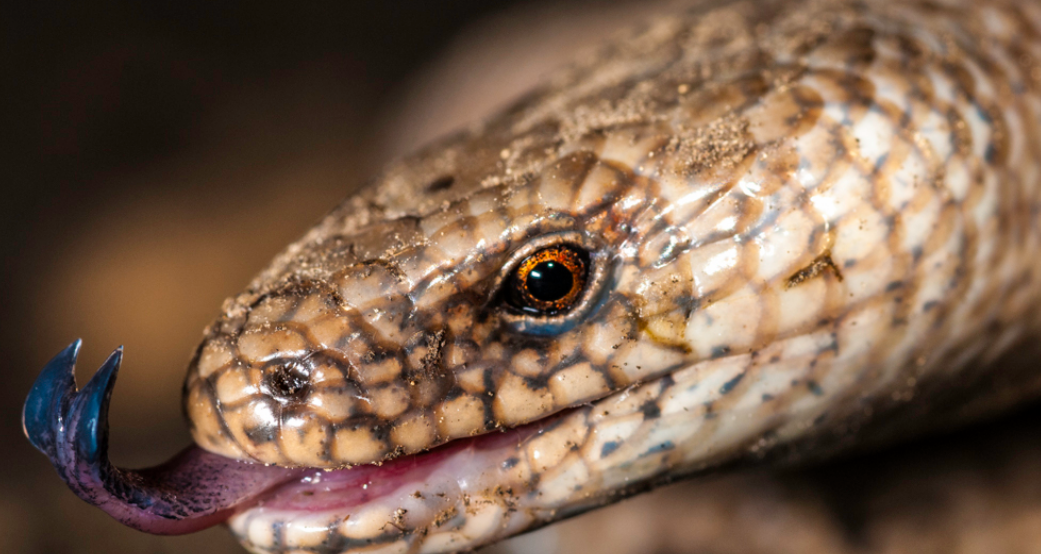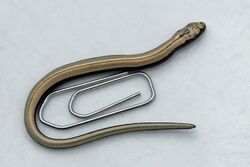The slow worm (Anguis fragilis) is a reptile native to western Eurasia. It is also called a deaf adder, a slowworm, a blindworm, or regionally, a long-cripple. These legless lizards are also sometimes called common slowworms. The "blind" in blindworm refers to the lizard's small eyes, similar to a blindsnake (although the slowworm's eyes are functional). Slow worms are semifossorial (burrowing) lizards, spending much of their time hiding underneath objects. The skin of slow worms is smooth with scales that do not overlap one another. Like many other lizards, they autotomize, meaning that they have the ability to shed their tails to escape predators. While the tail regrows, it does not reach its original length. In the UK, they are common in gardens, and can be encouraged to enter and help remove pest insects by placing black plastic or a piece of tin on the ground. On warm days, one or more slow worms can often be found underneath these heat collectors. One of the biggest causes of mortality in slow worms in suburban areas is the domestic cat, against which it has no defense. Slow worms have been shown to be a species complex, consisting of 5 distinct but similar species.
- black plastic
- slowworm
- regionally
1. Taxonomy

Anguis fragilis was traditionally divided into two subspecies (A. f. fragilis and A. f. colchica), but they are now classified as separate species:[1]
- Anguis fragilis sensu stricto (found in western Europe, northern Europe and western Balkans) and
- Anguis colchica (found in eastern Europe, eastern Balkans and in western Asia).
Three more species were later distinguished from A. fragilis:
- Anguis graeca (found in southern Balkans) and
- Anguis veronensis (found on the Apennine Peninsula).
- Anguis cephalonica (native to the Peloponnese Peninsula)
2. Physical Traits

Slow worms have an elongated body with a circular cross-section without limbs and reach a maximum length of up to 57.5 cm.[2] Most of the adult animals that can be observed are between 40 and 45 cm long, with up to 22 cm on the head and trunk section and the rest on the tail.[3] There is no visible neck. The tail, which ends in a horny tip, is continuous with the trunk and is often slightly longer. Slow worms exhibit caudal autotomy, the severing of the tail when it is pulled by predators. When regrown the tail only grows back to a short stub.
The skin surface consists of smooth, round to hexagonal scales that overlap like roof tiles and are roughly the same shape on the dorsal and ventral surfaces of the body. There are several longitudinal rows running along the underside. In total, the trunk has 125 to 150 transverse scale rows and the tail has another 130 to 160 rows. Under the scales there are bony plates (osteoderms), which means that slow worms crawl much more stiffly and clumsily than snakes. The scaling of the head is similar to that of other lizards. The ear openings are mostly completely hidden under the scales. The relatively small eyes have movable, closable eyelids (these are fused in snakes) and round pupils. The rather short tongue is broad, bilobed and does not end in fine tips. To lick, i.e. to absorb odorous substances, slow worms have to open their mouths slightly, as they lack the gap in the upper lip that snakes possess. The pointed, sometimes quite loosely fixed teeth are curved backwards; there are 7 to 9 teeth in the premaxilla, 10 to 12 in the maxilla and 14 to 16 in the lower jaw.

Close-up of the head of a slow worm. https://handwiki.org/wiki/index.php?curid=1584995
These reptiles are mostly active during the twilight and occasionally bask in the sun, but are more often found hiding beneath rocks and logs. They are carnivorous and, because they feed on slugs and worms, they can often be found in long grass and other damp environments.
2.1. Reproduction

In Central Europe, the mating season of the species is usually between the end of April and June. The males wrestle often violently around the females, although in most populations they are in the majority. The opponents try to push each other to the ground, bite each other and wrap themselves tightly around each other. When mating, the female is bitten in the head or neck region, while the male introduces his two hemipenes into the female's cloaca. Copulation can take several hours. Sometimes females mate with other males later. The gestation period of the females lasts 11 to 14 weeks; subsequently - between mid-July and the end of August, sometimes even later - they usually wean between eight and twelve young (extreme values: 2 to 28). Slow worms are ovoviviparous; at birth, the 7 to 10 cm long young animals are in a very thin, transparent egg shell, which they pierce immediately afterwards. They initially weigh less than a gram and still have a remnant of the yolk. Juvenile slow worms have a contrasting color scheme and pattern. The top of the body is silvery-white to golden yellow, while the sides and underside are black.
2.2. Size and Longevity
Adult slow worms grow to be about 50 cm (20") long, and are known for their exceptionally long lives; the slow worm may be the longest-living lizard, living about 30 years in the wild and up to at least 54 years in captivity (this record is held by a male slow worm that lived at the Copenhagen Zoo from 1892 until 1946, the age when first obtained is unknown).[4][5] The female often has a stripe along the spine and dark sides, while the male may have blue spots dorsally. Juveniles of both sexes are gold with dark brown bellies and sides with a dark stripe along the spine.
3. Protected Status in the UK
In the United Kingdom, the slow worm has been granted protected status, alongside all other native British reptile species. The slow worm has been decreasing in numbers, and under the Wildlife and Countryside Act 1981, to intentionally kill, injure, sell, or advertise to sell them is illegal.[6][7]
4. Ireland
The slow worm is not native to Ireland, but is believed to have been illegally introduced in the 1970s. It has been sighted only in parts of County Clare, mainly in the Burren region.[8][9][10]
5. Evolutionary History
Members of the genus Anguis, to which the slow worm belongs, first appeared during Europe during Mammal Paleogene zone 14, between 43.5 and 41.2 million years ago, corresponding to the Lutetian stage of the Eocene.[11] Remains assigned to the Anguis fragilis species complex are known from the late Miocene onwards.[12]
6. Gallery
-

Slow worm close.
-

A slow worm.
-


A slow worm moving through grass. This individual is a juvenile, as evidenced by its golden colouration.
The content is sourced from: https://handwiki.org/wiki/Biology:Slow_worm
References
- "Živa – Přehlížená rozmanitost slepýšů (Jiří Moravec, Václav Gvoždík)". https://ziva.avcr.cz/2019-5/prehlizena-rozmanitost-slepysu.html.
- Wolfgang Böhme: A record-sized specimen of the western slow worm (Anguis fragilis). In: Zeitschrift für Feldherpetologie. Bd. 19, Nr. 1, 2012, ISSN 0946-7998, S. 117–118.
- Dieter Glandt: Die Amphibien und Reptilien Europas. Alle Arten im Porträt. Quelle & Meyer Verlag, Wiebelsheim 2015, ISBN:978-3-494-01581-1, S. 322–327.
- Smith, Malcolm (1951). "The British Amphibians and Reptiles". http://www.newnaturalists.com/product/9780007308156/The+British+Amphibians+and+Reptiles.
- "Slow Worm". http://www.fourmilab.ch/images/animal_magnetism/notasnake.html.
- "BBC - Science & Nature - Wildfacts - Slow worm". BBC. http://www.bbc.co.uk/nature/wildfacts/factfiles/281.shtml.
- "Wildlife and Countryside Act 1981". Legislation.gov.uk. http://www.legislation.gov.uk/ukpga/1981/69.
- Irish Wildlife Trust Lizard Survey http://www.biology.ie/group.php?m=lizard&g=79
- "Archived copy". http://www.npws.ie/media/npwsie/content/images/protectedsites/sitesynopsis/SY001926.pdf.
- Dick Warner. "Slow worm makes its entrance". Irish Examiner. https://www.irishexaminer.com/opinion/columnists/arid-20225783.html.
- Rage, Jean-Claude (December 2012). "Amphibians and squamates in the Eocene of Europe: what do they tell us?" (in en). Palaeobiodiversity and Palaeoenvironments 92 (4): 445–457. doi:10.1007/s12549-012-0087-3. ISSN 1867-1594. http://link.springer.com/10.1007/s12549-012-0087-3.
- Villa, Andrea; Delfino, Massimo (November 2019). "Fossil lizards and worm lizards (Reptilia, Squamata) from the Neogene and Quaternary of Europe: an overview" (in en). Swiss Journal of Palaeontology 138 (2): 177–211. doi:10.1007/s13358-018-0172-y. ISSN 1664-2384. https://dx.doi.org/10.1007%2Fs13358-018-0172-y
 Encyclopedia
Encyclopedia
